Mozambique
This article needs additional citations for verification. (January 2009) |
Republic of Mozambique República de Moçambique | |
|---|---|
| Anthem: Pátria Amada (formerly Viva, Viva a FRELIMO) | |
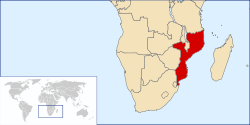 | |
| Capital and largest city | Maputo |
| Official languages | Portuguese |
| Demonym(s) | Mozambican |
| Government | Republic |
| Armando Guebuza | |
| Luísa Diogo | |
| Independence | |
• from Portugal | June 25 1975 |
| Area | |
• Total | 801,590 km2 (309,500 sq mi) (35th) |
• Water (%) | 2.2 |
| Population | |
• 2007 census | 21,397,000 (52nd) |
• Density | 25/km2 (64.7/sq mi) (178th) |
| GDP (PPP) | 2008 estimate |
• Total | $18.6 billion[1] |
• Per capita | $896[1] |
| GDP (nominal) | 2008 estimate |
• Total | $9.654 billion[1] |
• Per capita | $465[1] |
| Gini (1996–97) | 39.6 medium inequality |
| HDI (2007) | Error: Invalid HDI value (175th) |
| Currency | Mozambican metical (Mtn) (MZN) |
| Time zone | UTC+2 (CAT) |
• Summer (DST) | UTC+2 (not observed) |
| Driving side | left |
| Calling code | 258 |
| ISO 3166 code | MZ |
| Internet TLD | .mz |
| |
Mozambique, officially the Republic of Mozambique (Portuguese: Moçambique or República de Moçambique, pronounced [ʁɛˈpublikɐ di musɐ̃ˈbiki]), is a country in southeastern Africa bordered by the Indian Ocean to the east, Tanzania to the north, Malawi and Zambia to the northwest, Zimbabwe to the west and Swaziland and South Africa to the southwest. It was explored by Vasco da Gama in 1498 and colonized by Portugal in 1505. By 1510, the Portuguese had virtual control of all of the former Swahili sultanates on the East African coast. From about 1500, Portuguese trading posts and forts became regular ports of call on the new route to the east. Mozambique became independent in 1975, to which it became the People's Republic of Mozambique shortly after, and was the scene of an intense civil war lasting from 1977 to 1992. The country is a member of the Community of Portuguese Language Countries and the Commonwealth of Nations and an observer of the Francophonie. The country was named Moçambique by the Portuguese after Msumbiji, the Swahili name of Mozambique Island and port-town. Mozambique's life expectancy and infant mortality rates are both among the worst ranked in the world. Its Human Development Index is one of the lowest on earth.
History
Early migrations
Between the first and fourth centuries AD, waves of Bantu-speaking people migrated from the west and north through the Zambezi River valley and then gradually into the plateau and coastal areas. They established agricultural communities or societies based on herding cattle. They brought with them iron making technology which they used to make weapons for the conquest of their neighbors. Cities in Mozambique during its Middle Ages[when?] were not sturdily built, so there is little left of many medieval cities such as the trading port Sofala. Nevertheless several Swahili trade ports dotted the coast of the country before the arrival of Arabs and the Portuguese[2] which had been trading with Madagascar and the Far East.
Swahili and Portuguese rule
When Portuguese explorers reached East Africa in 1498, Swahili[2] commercial settlements had existed along the coast and outlying islands for several centuries. From about 1500, Portuguese trading posts and forts became regular ports of call on the new route to the east.
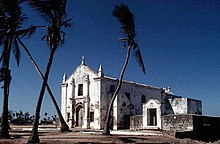
The voyage of Vasco da Gama around the Cape of Good Hope into the Indian Ocean in 1498 marked the Portuguese entry into trade, politics, and society in the Indian Ocean world. The Portuguese gained control of the Island of Mozambique and the port city of Sofala in the early 16th century, and by the 1530s small groups of Portuguese traders and prospectors penetrated the interior regions seeking gold, where they set up garrisons and trading posts at Sena and Tete on the Zambezi River and tried to gain exclusive control over the gold trade. The Portuguese attempted to legitimate and consolidate their trade and settlement positions through the creation of prazos (land grants) tied to Portuguese settlement and administration. While prazos were originally developed to be held by Portuguese, through intermarriage they became African Portuguese or African Indian centres defended by large African slave armies known as Chikunda. Historically within Mozambique there was slavery. Human beings were bought and sold by African tribal chiefs, Arab traders, and the Portuguese. Many Mozambican slaves were supplied by tribal chiefs who raided warring tribes and sold their captives to the prazeiros.[3]
Although Portuguese influence gradually expanded, its power was limited and exercised through individual settlers and officials who were granted extensive autonomy. The Portuguese were able to wrest much of the coastal trade from Arabs between 1500 and 1700, but, with the Arab seizure of Portugal's key foothold at Fort Jesus on Mombasa Island (now in Kenya) in 1698, the pendulum began to swing in the other direction. As a result, investment lagged while Lisbon devoted itself to the more lucrative trade with India and the Far East and to the colonisation of Brazil. During the 18th and 19th centuries the Mazrui and Omani Arabs reclaimed much of the Indian Ocean trade, forcing the Portuguese to retreat south. Many prazos had declined by the mid-19th century, but several of them survived. During the 19th century other European powers, particularly the British (British South Africa Company) and the French (Madagascar), became increasingly involved in the trade and politics of the region around the Portuguese East African territories.
By the early 20th century the Portuguese had shifted the administration of much of Mozambique to large private companies, like the Mozambique Company, the Zambezia Company and the Niassa Company, controlled and financed mostly by the British, which established railroad lines to neighbouring countries. Although slavery had been legally abolished in Mozambique, at the end of the 19th century the Chartered companies enacted a forced labor policy and supplied cheap – often forced – African labor to the mines and plantations of the nearby British colonies and South Africa. The Zambezia Company, the most profitable chartered company, took over a number of smaller prazeiro holdings, and established military outposts to protect its property. The chartered companies built roads and ports to bring their goods to market including a railroad linking present day Zimbabwe with the Mozambican port of Beira.[4][5]
Because of their unsatisfactory performance and because of the shift, under the Estado Novo regime of Oliveira Salazar, towards a stronger Portuguese control of Portuguese empire's economy, the companies' concessions were not renewed when they ran out. This was what happened in 1942 with the Mozambique Company, which however continued to operate in the agricultural and commercial sectors as a corporation, and had already happened in 1929 with the termination of the Niassa Company's concession. In 1951, the Portuguese overseas colonies in Africa were rebranded as Overseas Provinces of Portugal.[4][5][6]
Independence movement
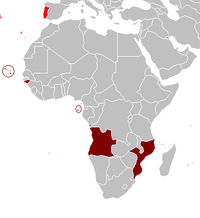
As communist and anti-colonial ideologies spread out across Africa, many clandestine political movements were established in support of Mozambican independence. These movements claimed that since policies and development plans were primarily designed by the ruling authorities for the benefit of Mozambique's Portuguese population, little attention was paid to Mozambique's tribal integration and the development of its native communities.[7] According to the official guerrilla statements, this affected a majority of the indigenous population who suffered both state-sponsored discrimination and enormous social pressure. Many felt they had received too little opportunity or resources to upgrade their skills and improve their economic and social situation to a degree comparable to that of the Europeans. Statistically, Mozambique's Portuguese whites were indeed wealthier and more skilled than the black indigenous majority. As a response to the guerrilla movement, the Portuguese government from the 1960s and principally the early 1970s, initiated gradual changes with new socioeconomic developments and equalitarian policies for all. [citation needed]
The Front for the Liberation of Mozambique (FRELIMO), initiated a guerrilla campaign against Portuguese rule in September 1964. This conflict, along with the two others already initiated in the other Portuguese colonies of Angola and Portuguese Guinea, became part of the so-called Portuguese Colonial War (1961–1974). From a military standpoint, the Portuguese regular army maintained control of the population centres while the guerrilla forces sought to undermine their influence in rural and tribal areas in the north and west. As part of their response to FRELIMO the Portuguese government began to pay more attention to creating favourable conditions for social development and economic growth.[8]
After 10 years of sporadic warfare and Portugal's return to democracy through a leftist military coup in Lisbon which replaced Portugal's Estado Novo regime for a military junta (the Carnation Revolution of April 1974), FRELIMO took control of the territory. Within a year, most of the 250,000 Portuguese in Mozambique had left – some expelled by the government of the newly-independent territory, some fleeing in fear – and Mozambique became independent from Portugal on June 25, 1975.[9]
Conflict and civil war
The new government, under president Samora Machel, gave shelter and support to South African (African National Congress) and Zimbabwean (Zimbabwe African National Union) liberation movements while the governments of first Rhodesia and later South Africa (at that time still operating the Apartheid laws) fostered and financed an armed rebel movement in central Mozambique called the Mozambican National Resistance (RENAMO). Starting shortly after the independence, the country was plagued from 1977 to 1992 by a long and violent civil war between the opposition forces of FRELIMO and RENAMO - the Mozambican Civil War. Hence, civil war, combined with sabotage from the neighbouring white-ruled state of Rhodesia and the Apartheid regime of South Africa, unwise Marxist policies, failed central planning and the resulting economic collapse, characterized the first decades of Mozambican independence. Also marking this period were the mass exodus of Portuguese nationals and Mozambicans of Portuguese heritage,[10] a collapsed infrastructure, and government nationalisation of privately owned industries. During most of the civil war, the government was unable to exercise effective control outside of urban areas, many of which were cut off from the capital. An estimated one million Mozambicans perished during the civil war, 1.7 million took refuge in neighbouring states, and several million more were internally displaced.[11]
On October 19, 1986 Samora Machel was on his way back from an international meeting in Zambia in the presidential Tupolev Tu-134 aircraft when the plane crashed in the Lebombo Mountains, near Mbuzini. There were ten survivors but President Machel and thirty-three others died, including ministers and officials of the Mozambique government. The United Nations' Soviet Union delegation issued a minority report contending that their expertise and experience had been undermined by the South Africans. Representatives of the Soviet Union advanced the theory that the plane had been intentionally diverted by a false navigational beacon signal, using a technology provided by military intelligence operatives of the South African government.[12]
Machel's successor, Joaquim Chissano, continued the reforms and began peace talks with RENAMO. The new constitution enacted in 1990 provided for a multi-party political system, market-based economy, and free elections. The civil war ended in October 1992 with the Rome General Peace Accords, first brokered by the CCM, the Christian Council of Mozambique (Council of Protestant Churches) and then taken over by Community of Sant'Egidio. Under supervision of the ONUMOZ peacekeeping force of the United Nations, peace returned to Mozambique.
By mid-1995 more than 1.7 million Mozambican refugees who had sought asylum in neighbouring Malawi, Zimbabwe, Swaziland, Zambia, Tanzania, and South Africa as a result of war and drought had returned, as part of the largest repatriation witnessed in sub-Saharan Africa. Additionally, a further estimated four million internally displaced persons returned to their areas of origin. [citation needed]
Foreign relations
While allegiances dating back to the liberation struggle remain relevant, Mozambique's foreign policy has become increasingly pragmatic. The twin pillars of Mozambique's foreign policy are maintenance of good relations with its neighbors and maintenance and expansion of ties to development partners.
During the 1970s and the early 1980s, Mozambique's foreign policy was inextricably linked to the struggles for majority rule in Rhodesia and South Africa as well as superpower competition and the Cold War. Mozambique's decision to enforce UN sanctions against Rhodesia and deny that country access to the sea led Ian Smith's government to undertake overt and covert actions to destabilize the country. Although the change of government in Zimbabwe in 1980 removed this threat, the government of South Africa continued to finance the destabilization of Mozambique. Mozambique also belonged to the Front Line States.
The 1984 Nkomati Accord, while failing in its goal of ending South African support to RENAMO, opened initial diplomatic contacts between the Mozambican and South African governments. This process gained momentum with South Africa's elimination of apartheid, which culminated in the establishment of full diplomatic relations in October 1993. While relations with neighbouring Zimbabwe, Malawi, Zambia, and Tanzania show occasional strains, Mozambique's ties to these countries remain strong.
In the years immediately following its independence, Mozambique benefited from considerable assistance from some Western countries, notably the Scandinavians. The Soviet Union and its allies, however, became Mozambique's primary economic, military, and political supporters and its foreign policy reflected this linkage. This began to change in 1983; in 1984 Mozambique joined the World Bank and International Monetary Fund. Western aid by the Scandinavian countries of Sweden, Norway, Denmark and Iceland quickly replaced Soviet support. Finland [13] and the Netherlands are becoming increasingly important sources of development assistance. Italy also maintains a profile in Mozambique as a result of its key role during the peace process. Relations with Portugal, the former colonial power, continue to be important, as Portuguese investors play a visible role in Mozambique's economy.
Mozambique is a member of the Non-Aligned Movement and ranks among the moderate members of the African bloc in the United Nations and other international organisations. Mozambique also belongs to the African Union (formerly the Organisation of African Unity) and the Southern African Development Community. In 1994, the government became a full member of the Organisation of the Islamic Conference, in part to broaden its base of international support but also to please the country's sizable Muslim population. Similarly, in early 1996 Mozambique joined its Anglophone neighbours in the Commonwealth of Nations. It is the only nation to join the Commonwealth that was never part of the British Empire. In the same year, Mozambique became a founding member and the first President of the Community of Portuguese Language Countries (CPLP), and maintains close ties with other Lusophone states.
Provinces, districts, and postos
Mozambique is divided into ten provinces (provincias) and one capital city (cidade capital) with provincial status. The provinces are subdivided into 129 districts (distritos). The districts are further divided in 405 "Postos Administrativos" (Administrative Posts) and then into Localidades (Localities), the lowest geographical level of the central state administration. Since 1998, 33 "Municípios" (Municipalities) have been created in Mozambique.
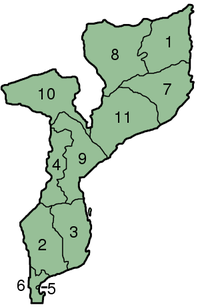 |
Geography and climate
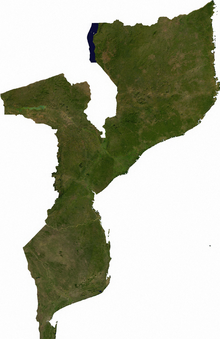
At 309,475 square miles (801,590 km²), Mozambique is the world's 35th-largest country (after Pakistan). It is comparable in size to Turkey.
Mozambique is located on the southeast coast of Africa. It is bound by Swaziland to the south, South Africa to the southwest, Zimbabwe to the west, Zambia and Malawi to the northwest, Tanzania to the north and the Indian Ocean to the east. The country is divided into two topographical regions by the Zambezi River. To the north of the Zambezi River, the narrow coastline moves inland to hills and low plateaus, and further west to rugged highlands, which include the Niassa highlands, Namuli or Shire highlands, Angonia highlands, Tete highlands and the Makonde plateau. To the south of the Zambezi River, the lowlands are broader with the Mashonaland plateau and Lebomo mountains located in the deep south.
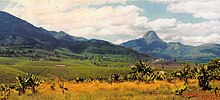
The country is drained by five principal rivers and several smaller ones with the largest and most important the Zambezi. The country has three lakes, Lake Niassa or Malawi, Lake Chiuta and Lake Shirwa, all in the north. The major cities are Maputo, Beira, Nampula, Tete, Quelimane, Chimoio, Pemba, Inhambane, Xai-Xai and Lichinga.
Mozambique has a tropical climate with two seasons, a wet season from October to March and a dry season from April to September. Climatic conditions, however, vary depending on altitude. Rainfall is heavy along the coast and decreases in the north and south. Annual precipitation varies from 500 to 900 mm (20 to 35 inches) depending on the region with an average of 590 mm (23 inches). Cyclones are also common during the wet season. Average temperature ranges in Maputo are from 13 to 24 degrees Celsius (55 to 75 degrees Fahrenheit) in July to 22 to 31 degrees Celsius (72 to 88 degrees Fahrenheit) in February.
Politics
Mozambique is a multi-party democracy under the 1990 constitution. The executive branch comprises a president, prime minister, and Council of Ministers. There is a National Assembly and municipal assemblies. The judiciary comprises a Supreme Court and provincial, district, and municipal courts. Suffrage is universal at eighteen.
In the 1994 elections, Joaquim Chissano was elected President with 53% of the vote, and a 250-member National Assembly was voted in with 129 Liberation Front of Mozambique (FRELIMO) deputies, 112 Mozambican National Resistance (RENAMO) deputies, and nine representatives of three smaller parties that formed the Democratic Union (UD). Since its formation in 1994, the National Assembly has made progress in becoming a body increasingly more independent of the executive. By 1999, more than one-half (53%) of the legislation passed originated in the Assembly.
After some delays, in 1998 the country held its first local elections to provide for local representation and some budgetary authority at the municipal level. The principal opposition party, RENAMO, boycotted the local elections, citing flaws in the registration process. Independent slates contested the elections and won seats in municipal assemblies. Turnout was very low.
In the aftermath of the 1998 local elections, the government resolved to make more accommodations to the opposition's procedural concerns for the second round of multiparty national elections in 1999. Working through the National Assembly, the electoral law was rewritten and passed by consensus in December 1998. Financed largely by international donors, a very successful voter registration was conducted from July to September 1999, providing voter registration cards to 85% of the potential electorate (more than seven million voters).
The second general elections were held December 3–5, 1999, with high voter turnout. International and domestic observers agreed that the voting process was well organized and went smoothly. Both the opposition and observers subsequently cited flaws in the tabulation process that, had they not occurred, might have changed the outcome. In the end, however, international and domestic observers concluded that the close result of the vote reflected the will of the people.
President Chissano won the presidency with a margin of 4% points over the RENAMO-Electoral Union coalition candidate, Afonso Dhlakama, and began his five-year term in January, 2000. FRELIMO increased its majority in the National Assembly with 133 out of 250 seats. RENAMO-UE coalition won 116 seats, one went independent, and no third parties are represented.
The opposition coalition did not accept the National Election Commission's results of the presidential vote and filed a formal complaint to the Supreme Court. One month after the voting, the court dismissed the opposition's challenge and validated the election results. The opposition did not file a complaint about the results of the legislative vote.
The second local elections, involving thirty-three municipalities with some 2.4 million registered voters, took place in November 2003. This was the first time that FRELIMO, RENAMO-UE, and independent parties competed without significant boycotts. The 24% turnout was well above the 15% turnout in the first municipal elections. FRELIMO won twenty-eight mayoral positions and the majority in twenty-nine municipal assemblies, while RENAMO won five mayoral positions and the majority in four municipal assemblies. The voting was conducted in an orderly fashion without violent incidents. However, the period immediately after the elections was marked by objections about voter and candidate registration and vote tabulation, as well as calls for greater transparency.
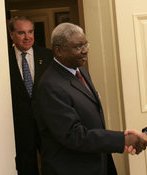
In May 2004, the government approved a new general elections law that contained innovations based on the experience of the 2003 municipal elections.
Presidential and National Assembly elections took place on December 1–2, 2004. FRELIMO candidate Armando Guebuza won with 64% of the popular vote. His opponent, Afonso Dhlakama of RENAMO, received 32% of the popular vote. FRELIMO won 160 seats in Parliament. A coalition of RENAMO and several small parties won the 90 remaining seats. Armando Guebuza was inaugurated as the President of Mozambique on February 2, 2005. RENAMO and some other opposition parties made claims of election fraud and denounced the result. These claims were supported by international observers (among others by the European Union Election Observation Mission to Mozambique and the Carter Centre) to the elections who criticised the fact that the National Electoral Commission (CNE) did not conduct fair and transparent elections. They listed a whole range of shortcomings by the electoral authorities that benefited the ruling party FRELIMO. However, according to EU observers, the elections shortcomings have probably not affected the final result in the presidential election. On the other hand, the observers have declared that the outcome of the parliamentary election and thus the distribution of seats in the National Assembly does not reflect the will of the Mozambican people and is clearly to the disadvantage of RENAMO.
Economy
This article needs to be updated. (April 2009) |

The official currency is the New Metical (as of 2009, 1 USD is roughly equivalent to 27 Meticals), which replaced old Meticals at the rate of a thousand to one. The old currency will be redeemed by the Bank of Mozambique until the end of 2012. The US dollar, South African rand, and recently the euro are also widely accepted and used in business transactions. The minimum legal salary is around US$60 per month. Mozambique is a member of the Southern African Development Community (SADC). The SADC free trade protocol is aimed at making the Southern African region more competitive by eliminating tariffs and other trade barriers. The World Bank in 2007 talked of Mozambique’s ‘blistering pace of economic growth’. A joint donor-government study in early 2007 said ‘Mozambique is generally considered an aid success story.’ The IMF in early 2007 said ‘Mozambique is a success story in Sub-Saharan Africa.’ Yet, despite this apparent success, both the World Bank and UNICEF used the word ‘paradox’ to describe rising chronic child malnutrition in the face of GDP growth. Between 1994 and 2006, average annual GDP growth was approximately 8%, however, the country remains one of the poorest and most underdeveloped in the world. In a 2006 survey, three-quarters of Mozambicans said that in the past five years their economic position had remained the same or become worse.[14]
Rebounding growth
The resettlement of civil war refugees and successful economic reform have led to a high growth rate: the country has enjoyed a remarkable recovery, achieving an average annual rate of economic growth of 8% between 1996 and 2006. [15] The devastating floods of early 2000 slowed GDP growth to 2.1%. A full recovery was achieved with growth of 14.8% in 2001. In 2003, the growth rate was 7%. The government projects the economy to continue to expand between 7%-10% a year for the next five years, although rapid expansion in the future hinges on several major foreign investment projects, continued economic reform, and the revival of the agriculture, transportation, and tourism sectors. More than 75% of the population engages in small-scale agriculture, which still suffers from inadequate infrastructure, commercial networks, and investment. However, 88% of Mozambique's arable land is still uncultivated. [citation needed]
In addition, the profitable exploitation of valuable titanium reserves has the potential to uplift this poverty-stricken region of Africa. As a natural resource, it could play a significant role in solving unemployment and poverty. [citation needed]
Inflation

The government's tight control of spending and the money supply, combined with financial sector reform, successfully reduced inflation from 70% in 1994 to less than 5% in 1998–99. Economic disruptions stemming from the devastating floods of 2000 caused inflation to jump to 12.7% that year, and it was 13% in 2003. Mozambique's currency, the Metical (MZM), devaluated by 50% to the dollar in 2001, although in late 2001 it began to stabilize. Since then, it has held steady at about 24,000 MZM to 1 U.S. dollar. New Metical replaced old Meticals at a rate of a thousand to one on January 1 2007, bringing the exchange rate to 25 (new) MZN to 1 USD.
Economic reforms
More than 1,200 state-owned enterprises (mostly small) have been privatised. Preparations for privatisation and/or sector liberalisation are underway for the remaining parastatal enterprises, including telecommunications, energy, ports, and railways. The government frequently selects a strategic foreign investor when privatising a parastatal. Additionally, customs duties have been reduced, and customs management has been streamlined and reformed. The government introduced a value-added tax in 1999 as part of its efforts to increase domestic revenues. Plans for 2003–04 include Commercial Code reform; comprehensive judicial reform; financial sector strengthening; continued civil service reform; and improved government budget, audit, and inspection capability. Further political instability resulting from the floods left thousands homeless, displaced within their own country.[citation needed]
Improving trade imbalance
Imports remain almost 40% greater than exports, but this is a significant improvement over the 4:1 ratio of the immediate post-war years. In 2003, imports were $1.24 billion and exports were $910 million. Support programs provided by foreign donors and private financing of foreign direct investment mega-projects and their associated raw materials have largely compensated for balance-of-payments shortfalls. The medium-term outlook for exports is encouraging, since a number of foreign investment projects should lead to substantial export growth and a better trade balance. MOZAL, a large aluminium smelter that commenced production in mid-2000, has greatly expanded the nation's trade volume. Traditional Mozambican exports include cashews, shrimp, fish, copra, sugar, cotton, tea, and citrus fruits. Most of these industries are being rehabilitated. As well, Mozambique is less dependent on imports for basic food and manufactured goods because of steady increases in local production.
Demographics

The north-central provinces of Zambezia and Nampula are the most populous, with about 45% of the population. The estimated four million Macua are the dominant group in the northern part of the country; the Sena and Shona (mostly Ndau) are prominent in the Zambezi valley, and the Shangaan (Tsonga) dominate in southern Mozambique. Other groups include Makonde, Yao, Swahili, Tonga, Chopi, and Nguni (including Zulu). Bantu people comprise 99.66% of the population, with the rest including White Africans (largely of Portuguese ancestry), Euro-Africans (mestiço people of mixed Bantu and Portuguese heritage), and Indians.[16] Roughly 20,000 people of Indian descent reside in Mozambique.[17] During Portuguese colonial rule, a large minority of people of Portuguese descent lived permanently in almost all areas of the country,[18] and Mozambicans with Portuguese blood at the time of independence numbered about 360,000. Many of these left the region after independence from Portugal in 1975. The remaining minorities in Mozambique claim heritage from Pakistan, Portuguese India, and Arab countries.[citation needed] There are various estimates for the size of Mozambique's Chinese community, ranging from 1,500 to 12,000 as of 2007[update].[19][20]
Despite the influence of Islamic coastal traders and European colonisers, the people of Mozambique have largely retained an indigenous culture based on small-scale agriculture. Mozambique's most well-known art forms are wood sculpture, for which the Makonde in northern Mozambique are particularly renowned, and dance. The middle and upper classes continue to be heavily influenced by the Portuguese colonial and linguistic heritage.
Languages
Portuguese is the official and most widely spoken language of the nation, but only 40% of all people speak it — 33.5%, mostly Bantus, as their second language and only 6.5%, mostly white Mozambicans and mestiços, as their first language. Bantus speak several of their different languages — most widely used of these are Swahili, Makhuwa, Sena, Ndau, and Shangaan — and these have many Portuguese-origin words. Arabs, Chinese, and Indians speak their own languages (Indians from Portuguese India speak any of the Portuguese Creoles of their origin) aside from Portuguese as their second language. Most educated Mozambicans can also speak English, which is used in schools and business, as their second or third language.
Education

Since independence from Portugal in 1975, school construction and teacher training enrollments have not kept up with population increases. Especially after the Mozambican Civil War (1977-1992), with post-war enrollments reaching all-time highs due to stability and youth population growth, the quality of education suffered. All Mozambicans are required by law to attend school through the primary level; however, a lot of children in Mozambique do not go to primary school because they have to work for their families' subsistence farms for a living. In 2007, one million children still did not go to school, most of them from poor rural families, and almost half of all teachers in Mozambique were still unqualified. Girls’ enrollment increased from 3 million in 2002 to 4.1 million in 2006 while the completion rate increased from 31,000 to 90,000, which testified a very poor completion rate.[21]
After grade 7, students must take standardised national exams to enter secondary school, which runs from 8th to 10th grade. [citation needed] Space in Mozambican universities is extremely limited; thus most students who complete pre-university school do not immediately proceed on to university studies. Many go to work as teachers or are unemployed. There are also institutes which give more vocational training, specialising in agricultural, technical, or pedagogical studies, which students may attend after grade 10 in lieu of a pre-university school.
After independence from Portugal in 1975, a number of Mozambican students continued to be admitted every year at Portuguese high schools, polytechnical institutes, and universities, through bilateral agreements between the Portuguese government and the Mozambican government; in general these students come from the Mozambican elite. [citation needed]
Religion

The Roman Catholic Church has established twelve dioceses (Beira, Chimoio, Gurué, Inhambane, Lichinga, Maputo, Nacala, Nampula, Pemba, Quelimane, Tete, and Xai-Xai - archdioceses are Beira, Maputo and Nampula). Statistics for the dioceses range from a low 7.44% Catholics in the population in the diocese of Chimoio, to 87.50% in Quelimane diocese (2006 official Catholic figures).
Muslims are particularly present in the north of the country. They are organised in several "tariqa" or brotherhoods (of the Qadiriya or Shadhuliyyah branch). Two national organisations also exist - the Conselho Islamico de Moçambique (reformists) and the Congresso Islamico de Mocambique (pro-Sufi). There are also important Indo-Pakistani associations as well as some Shia and particularly Ismaili communities.
Among the main Protestant churches are Igreja União Baptista de Moçambique, the Assembleias de Deus, the Seventh-day Adventists, the Anglican Church of Southern Africa, the Igreja do Evangelho Completo de Deus, the Igreja Metodista Unida, the Igreja Presbiteriana de Moçambique, the Igreja de Cristo and the Assembleia Evangélica de Deus. The Church of Jesus Christ of Latter-day Saints is also present as well as the Jehovah's Witnesses, the Brazilian Igreja Universal do Reino de Deus and Igreja Crista Maranata.[citation needed]
According to the 1997 census, the Roman Catholic community makes up 23.8 percent of the population of Mozambique. Muslims comprise 17.8 percent of the population, and people of the Protestant community make up 17.5% of the country's population. 17.8% of the people have other beliefs, and 23.1% have no religious beliefs.[16]
See also
- Communications in Mozambique
- Liga dos Escuteiros de Moçambique
- List of conservation areas of Mozambique
- Military of Mozambique
- Public holidays in Mozambique
- Transport in Mozambique
- Portuguese East Africa
References
This article includes a list of references, related reading, or external links, but its sources remain unclear because it lacks inline citations. (January 2009) |
![]() This article incorporates public domain material from The World Factbook. CIA.
This article incorporates public domain material from The World Factbook. CIA.
- ^ a b c d "Mozambique". International Monetary Fund. Retrieved 2009-04-22.
- ^ a b Mozambique by Philip Briggs and Danny Edmunds
- ^ Arming Slaves, Arming slaves: from classical times to the modern age, Christopher Leslie Brown, Philip D. Morgan, Gilder Lehrman: Center for the Study of Slavery, Resistance, and Abolition. Edition: Yale University Press, 2006 ISBN 0300109008, 9780300109009
- ^ a b The Cambridge history of Africa, The Cambridge history of Africa, John Donnelly Fage, A. D. Roberts, Roland Anthony Oliver, Edition: Cambridge University Press, 1986, ISBN 0521225051, 9780521225052
- ^ a b The Third Portuguese Empire, 1825-1975, The Third Portuguese Empire, 1825-1975: A Study in Economic Imperialism, W. G. Clarence-Smith, Edition: Manchester University Press ND, 1985, ISBN 071901719X, 9780719017193
- ^ Agência Geral do Ultramar, "Na sequência do Decreto-Lei nº 38.300 de 15 de Junho de 1951, que transformou o Ministério das Colónias em Ministério do Ultramar e o Conselho do Império Colonial em Conselho Ultramarino, foram também alterados alguns nomes, pela Portaria n.º 13.593 de 5 de Julho de 1951, ganhando a designação de Agência Geral do Ultramar e Boletim Geral do Ultramar. A Agência Geral do Ultramar continuou como organismo dependente do Ministério do Ultramar, na reorganização conferida pelo Decreto-Lei n.º 41.169 de 29 de Junho de 1959, e estava vocacionado para fomentar o conhecimento recíproco das províncias ultramarinas e da metrópole, a divulgar no estrangeiro informações relativas àquelas, a orientar e desenvolver o turismo nas províncias e a exercer na metrópole procuradoria de interesses ultramarinos, prevendo já os serviços administrativos, os de informação e relações exteriores, os de turismo, e os técnicos."
- ^ Independence redux in postsocialist Mozambique, Alice Dinerman
- ^ CD do Diário de Notícias - Parte 08
- ^ Carnation revolution, By Mia Couto, Le Monde diplomatique, April 2004
- ^ Dismantling the Portuguese Empire, Time Magazine (Monday, July 07, 1975).
- ^ A Mozambique Formally at Peace Is Bled by Hunger and Brutality, The New York Times, October 13, 1992
- ^ "Special Investigation into the death of President Samora Machel". Truth and Reconciliation Commission (South Africa) Report, vol.2, chapter 6a. Retrieved June 18 2006.
{{cite web}}: Check date values in:|accessdate=(help); Unknown parameter|dateformat=ignored (help) - ^ http://www.tpk.fi/netcomm/news/showarticle.asp?intNWSAID=71407&intSubArtID=28199
- ^ Is Poverty Decreasing in Mozambique?, Joseph Hanlon, Senior Lecturer, Open University, England - Paper to be presented at the Inaugural Conference of the Instituto de Estudos Sociais e Económicos (IESE) in Maputo, 19 September 2007.
- ^ http://www.iceida.is/english/main-activities/mozambique/
- ^ a b "Mozambique". CIA World Factbook. Retrieved 22 May 2007.
- ^ Singhvi 2000, p. 94
- ^ Mozambique (01/09), U.S. Department of State
- ^ Jian, Hong (2007), "莫桑比克华侨的历史与现状 (The History and Status Quo of Overseas Chinese in Mozambique)", West Asia and Africa (5), Chinese Academy of Social Sciences, ISSN 1002-7122, retrieved 2008-10-29
- ^ Horta, Loro (2007-08-13), "China, Mozambique: old friends, new business", International Relations and Security Network Update, retrieved 2007-11-03
- ^ Key facts, Department for International Development (DFID), a part of the UK Government (24 May 2007)
Bibliography
- Gengenbach, Heidi. Binding Memories: Women as Makers and Tellers of History in Magude, Mozambique. Columbia University Press, 2004. Entire Text Online: http://www.gutenberg-e.org/geh01/main.html
- Abrahamsson, Hans Mozambique: The Troubled Transition, from Socialist Construction to Free Market Capitalism London: Zed Books, 1995
- Cahen, Michel Les bandits: un historien au Mozambique_, Paris: Gulbenkian, 1994
- Pitcher, Anne Transforming Mozambique: The politics of privatisation, 1975–2000 Cambridge, 2002
- Newitt, Malyn A History of Mozambique Indiana University Press
- Varia, "Religion in Mozambique", LFM: Social sciences & Missions No. 17, December 2005
- Mwakikagile, Godfrey, Nyerere and Africa: End of an Era, Third Edition, New Africa Press, 2006, "Chapter Seven: "The Struggle for Mozambique: The Founding of FRELIMO in Tanzania," pp. 206–225, ISBN 978-0980253412; Mwakikagile, Godfrey, Africa and America in The Sixties: A Decade That Changed The Nation and The Destiny of A Continent, First Edition, New Africa Press, 2006, ISBN 978-0980253429
External links
- Government
- Republic of Mozambique Official Government Portal
- Health Ministry
- Science and Technology Portal
- National Petroleum Institute
- Instituto Nacional de Estatística[dead link] National Statistical Office
- Chief of State and Cabinet Members
- General information
- Country Profile from BBC News
- "Mozambique". The World Factbook (2024 ed.). Central Intelligence Agency.
- Mozambique from UCB Libraries GovPubs
- Mozambique at Curlie
 Wikimedia Atlas of Mozambique
Wikimedia Atlas of Mozambique
- Politics
- Tourism





